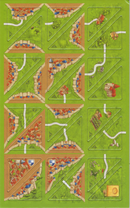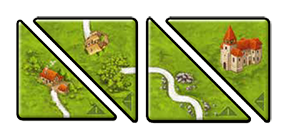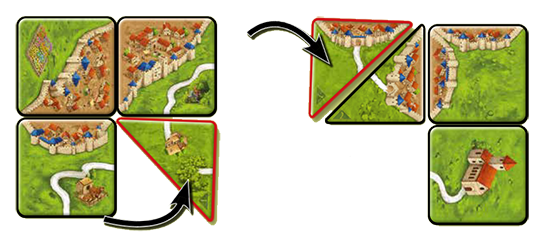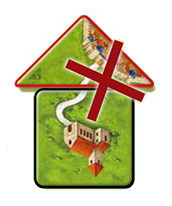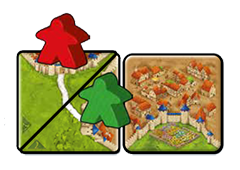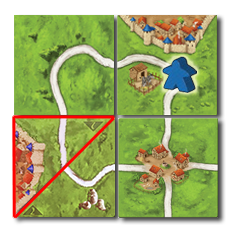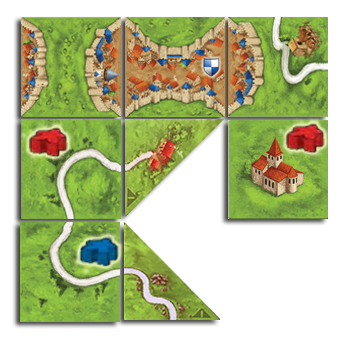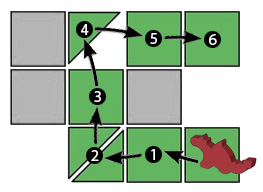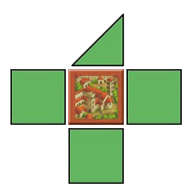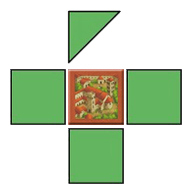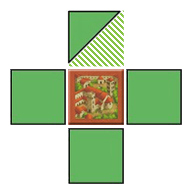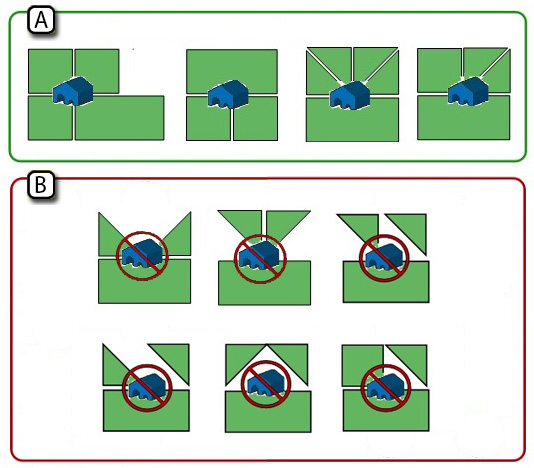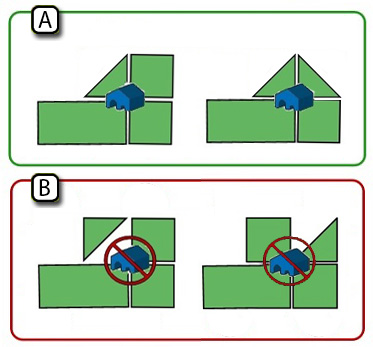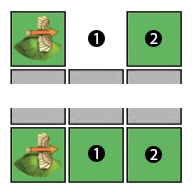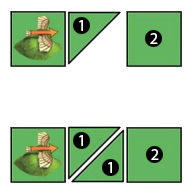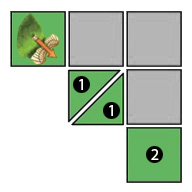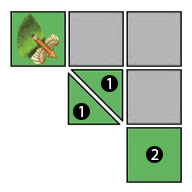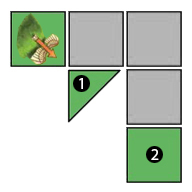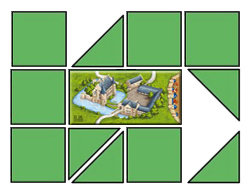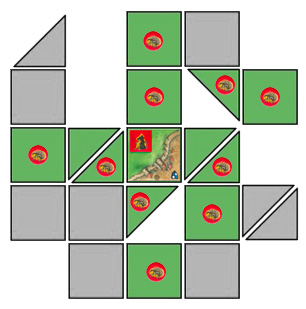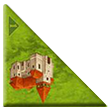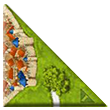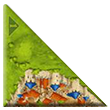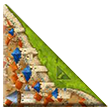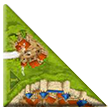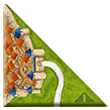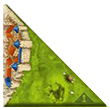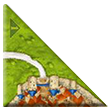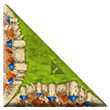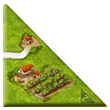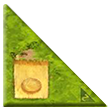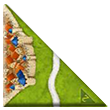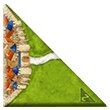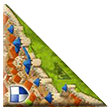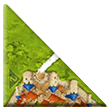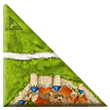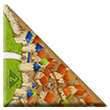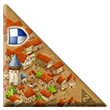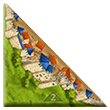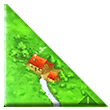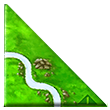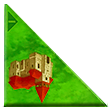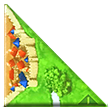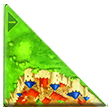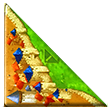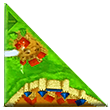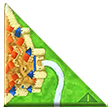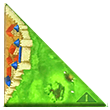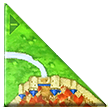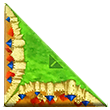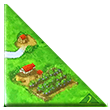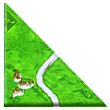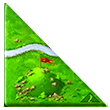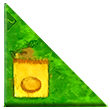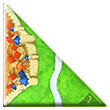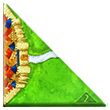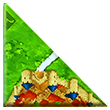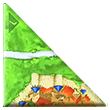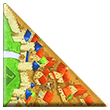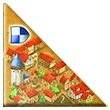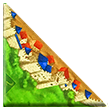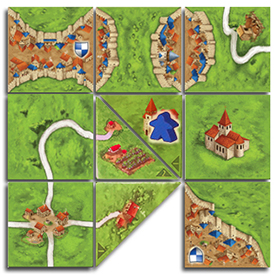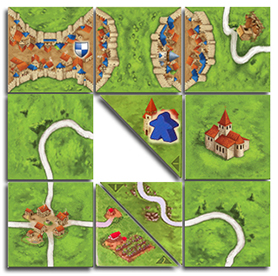Halflings
 |
You are reading the rules for this tile design. |  |
 | Read the following rules if your tiles look like this. |  |
| If your tiles have a different design, then choose a game from Spin-offs. |  |
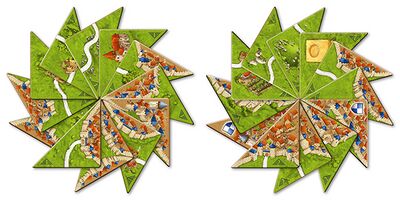 Sample of Halfling tiles for C2: the spirals show the Halfling I tiles (left) and the Halfling II tiles (right) |
 Sample of Halfling tiles for C3 |
General info and comments
 Halfings I symbol |
 Halfings II symbol |
Halflings was originally released for the 2nd Edition (C2 for shot) by Hans im Glück in 2020. It was later released for the 3rd Edition (C3 for short) in 2024.
This mini-expansion includes tiles of two mini-expansions published for the 1st Edition (C1 for short) in 2014. While tiles marked with ![]() match those of the version which was published in Spielbox magazine (www.spielboxshop.de), tiles marked with
match those of the version which was published in Spielbox magazine (www.spielboxshop.de), tiles marked with ![]() stem from another version which was originally available at www.cundco.de exclusively.
stem from another version which was originally available at www.cundco.de exclusively.
Contents
- 24 new “half-sized” triangular land tiles
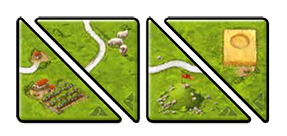
Rules
Preparation
For your first game shuffle all triangular tiles face down (except for those with symbols from expansions). Each player draws 3 triangular tiles, takes a look at them and puts their tiles in front of them face down.
If you have already played Halflings before, you can play the following version: At the beginning of the game put down all triangular tiles face up. Determine which player is first. The player whose turn is last, chooses a tile and places it in front of them face down. The remaining players continue to do the same counter-clockwise until everyone has drawn 3 tiles. The remaining triangular tiles are put back in the box. If you like to play using more triangular tiles, you can do so (depending on the number of players).
Gameplay
1. Placing a tile
Instead of drawing and placing a regular land tile you can choose to place one of your triangular tiles instead. The half-sized tiles are placed according to the rules of the Carcassonne base game, meaning that at least one side of your tile has to continue the landscape of one or more existing tiles. The long side of the triangular tile may never be placed next to a regular land tile continuing its landscape. You may however place a half-sized tile with its long side adjacent to that of another half-sized tile if it continues the landscape.
Special case: The game ends when nobody can place a land tile or a half-sized tile during their turn, even if other players still have half-sized tiles. [1] [2]
2. Placing a meeple
3. Scoring a feature
If you complete a feature with half-sized tiles, it is scored according to the normal rules but considering occupied spaces (areas) and not individual tiles. [5]
![]() Question: When scoring a city or a road, how should we consider two Halfling tiles in one space?
Question: When scoring a city or a road, how should we consider two Halfling tiles in one space?
Answer: The Halflings count as one occupied space (area). [Note that spaces occupied by one or two Halfling tiles are considered equivalent to a regular tile. -ed.] (1/2021)
> Roads and cities
As per the base game rules, completed cities cannot contain gaps. In this case, this means they cannot contain square or triangular gaps. Roads will follow the same rule: A road with a triangular gap will be considered incomplete too.
The scoring of a completed city or road will follow the normal rules but one or two triangular tiles in one square space will be counted as one regular tile.
> Monasteries
A triangular tile in the surroundings of a monastery is counted just like a regular land tile (it scores 1 point and can complete the monastery). The triangular tile does not have to be adjacent to the tile with the monastery itself in order to complete the monastery.
If two triangular tiles have been placed instead of a regular land tile, you still only score 1 point for this occupied space. [6]
Final Scoring
> Monasteries
At the end of the game, an incomplete monastery will score 1 point for the occupied space with the monastery tile and 1 point for each occupied adjacent space.
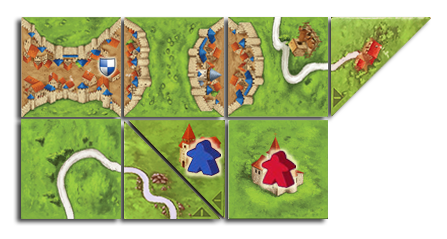
- 1 point for the space occupied by the monastery, even if it occupied by two triangular tiles
- 1 point for each adjacent space occupied by square tiles.
- 1 point for the space occupied by the monastery
- 1 point for the occupied adjacent spaces no matter if they have 1 or 2 triangular tiles or square tiles
> Fields
Field scoring is affected by the triangular gaps in the landscape. Triangular gaps interrupt the field continuity and define boundaries. (1/2021)
Tiles with expansion symbols
The following three tiles show symbols of the 9th expansion ![]() Hills & Sheep which rules do apply here. The rules of tiles 1 and 2 can be applied without further game material. In order to use the sheep on tile 3, you need material included in the 9th expansion.
Hills & Sheep which rules do apply here. The rules of tiles 1 and 2 can be applied without further game material. In order to use the sheep on tile 3, you need material included in the 9th expansion.
1 Vineyard | If a monastery is being completed and scored, its owner earns 3 extra points for each vineyard depicted on the tiles in the vicinity of the monastery (the square space with the monastery and the 8 spaces surrounding it). [7]
2 Hill | If you place the triangular tile depicting the hill, you draw a regular land tile according to the rules of the 9th expansion and place it under the hill tile. The free triangular space can later be filled by placing another half-sized tile. The hill counts for the whole space and therefore also for a potential second triangular tile. If you have a meeple on a feature with a hill, ties for scoring that feature are broken in your favor.
3 Sheep | You earn 3 points for the sheep on this tile if you guide your flock to the stable. [8] A wolf cannot scare these sheep away. [9]
The tile depicting the crop circle is played differently from the normal crop circle tiles (see ![]() Mini #7 - The Crop Circles).
Mini #7 - The Crop Circles).
4 Crop Circle | You play a normal turn with the crop circle tile. [10] Afterwards you determine a kind of meeple (knight, highwayman or farmer) and choose one of the following actions which all players (including yourself) must complete, starting with the player to your left:
Each player either... [11]
A) ... may take a meeple from their supply and place it next to another one of their meeples of this kind on the same land tile. [12]
OR
B) ... must remove one of their meeples of the determined kind from a land tile and put it back into their supply.
If a player does not have any meeples of the determined kind, they cannot complete neither action A nor B.
Rules changes
The Halflings rules have become a source of great controversy due to the many gaps and conclusions left to the reader.
The rules focus on explaining the especial case for monasteries only: The rules from 2014 did not even mention how roads and cities were to be scored and the rules from 2020 just indicate that completed roads and cities with triangular tiles are scored according to the normal rules.
In 2014, the lack of information about road and city scoring led to the interpretation that they should be scored according to the principle provided for monasteries that two triangular tiles in one square space were to be counted as one tile. This assumption would have some consequences when considering interactions with other expansions since triangular tiles would not be considered individual tiles in some cases.
- Scoring features with the rules from 2014:
- Roads and cities are scored according to the number of square tiles (2 triangular tiles are considered 1 square tile)
- Monasteries are scored according the square spaces with tiles (2 triangular tiles are considered 1 tile) - Monasteries can score up to 9 points
The clarifications from 10/2015 affected the scoring of cities and roads (each triangular tile would be considered individually from this moment on), but it changes the way monasteries should be scored, since each tile would be counted individually for monasteries too. So monasteries could score up to 18 points as you could cram that many Halflings tiles in the space occupied by a monastery and the 8 adjacent spaces. These clarifications covered some interactions with other expansions, not all of them, but provided some hints to address some other by analogy (with some house rules, if needed). They would represent a lot of consequences when considering interactions with other expansions since triangular tiles would be considered as individual tiles now. (Double-sized tile were considered individual tiles too, so this also added additional distortions to the way some expansions interacted).
- Scoring features with the clarifications from 10/2015:
- Roads and cities are scored according to the number of individual tiles (square, triangular or double sized)
- Monasteries are scored according the number of individual tiles (square, triangular or double sized) - Monasteries can score up to 18 points
Later in 2020, the re-release of Halflings for Carcassonne II included similar rules to those from 2014. There was a brief indication on how roads and cities should be scored and the rules for the monasteries were a step back from the clarifications from 10/2015, returning to the original ones from 2014. The clarifications from 10/2015 were still applied except for the scoring of monasteries (and therefore German castles by extension).
- Scoring features with the rules from 2020 + clarifications from 10/2015:
- Roads and cities are scored according to the number of individual tiles (square, triangular or double sized)
- Monasteries are scored according the square spaces with tiles (square, triangular or double sized) - Monasteries can score up to 9 points
A new set of clarifications were provided in 1/2021. These clarifications confirmed that the previous clarifications from 10/2015 were outdated and the same principles were applied to the scoring of roads, cities and monasteries. Therefore, the principles established in 2014 where to be applied universally.
- Scoring features with the clarifications from 1/2021:
- Roads and cities are scored according to the number of occupied spaces (2 triangular tiles are considered as 1 occupied square space)
- Monasteries are scored according the square spaces with tiles (square, triangular or double sized) - Monasteries can score up to 9 points
- Additionally, all expansions should consider occupied spaces for their mechanics: the dragon movement, the tower range, fliers, German castles...
The following table summarizes the evolution of the rules and its consequences.
| Rules Updates | |||||
|---|---|---|---|---|---|
| Feature | Tiles occupying a space | C1 rules from 2014 | Clarifications from 10/2015 | C2 rules from 2020 | Clarifications from 1/2021 |
| Final C1 rules | Final C2/C3 rules | ||||
| Road / City | Scored per tile | Scored per tile | Scored per tile | Scored per occupied space | |
| 1 square tile | 1 tile | 1 tile | 1 tile | 1 tile → 1 occupied space | |
| 1 triangular tile | 1 tile (1) | 1 tile | 1 tile | 1 tile → 1 occupied space | |
| 2 triangular tiles | 2 tiles → counted as 1 tile (1) | 2 tiles | 2 tiles | 2 tiles → 1 occupied space | |
| 1 part of double-sized tile | N/A (2) | 1 tile | 1 tile (3) | 1 tile part → 1 occupied space (6) | |
| Monastery | Scored per occupied space | Scored per tile | Scored per occupied space | Scored per occupied space | |
| 1 square tile | 1 tile → 1 occupied space | 1 tile | 1 tile → 1 occupied space | 1 tile → 1 occupied space | |
| 1 triangular tile | 1 tile → 1 occupied space | 1 tile (4) | 1 tile → 1 occupied space | 1 tile → 1 occupied space | |
| 2 triangular tiles | 2 tiles → 1 occupied space | 2 tiles (4) | 2 tiles → 1 occupied space | 2 tiles → 1 occupied space | |
| 1 part of double-sized tile | N/A (2) | 1 tile (4) | 1 tile → 1 or 2 occupied spaces (5) | 1 tile part → 1 occupied space | |
- Note:
- (1) There was no explicit mention in rules. It was assumed that triangular tiles on the same space were considered counted as 1 tile as an adaptation of the scoring rules for monasteries. This may be the result of a misinterpretation.
- (2) Double-sized tiles were released a year later so no provision for double-sized tiles is made in the rules from 2014.
- (3) Not covered in the rules, but aligned with the interpretation of the rules from 2020 and the clarifications from 10/2015.
- (4) Triangular tiles and double-sized tiles were counted as individual tiles for monasteries.
- (5) Not covered in the rules, but change consistent with monastery scoring by occupied space from 2020. It would override the clarifications provided in 10/2015.
- (6) Exception for C2 only: Roads in Leipzig tiles are counted as 1 tile even is spread across two spaces.
Other expansions
This section contains additional information about the interactions with other Carcassonne expansions.
![]() As a general rule, it was confirmed that all mechanics have to be implemented considering square spaces (areas) conforming a grid, so scorings, ranges and trajectories consider those spaces. As a result:
As a general rule, it was confirmed that all mechanics have to be implemented considering square spaces (areas) conforming a grid, so scorings, ranges and trajectories consider those spaces. As a result:
- Tiles are placed individually according to the usual rules (any effects triggered by the tile when drawn or placed will follow the usual rules).
- Figures and tokens are placed on tiles according to the usual rules.
- The grid of square spaces will be used as a reference framework for determining adjacency, feature/bonus/figure scoring, figure/token movements, action ranges, and trajectories. The rules considering regular square tiles will have to be interpreted as affecting any tiles overlapping a particular square space:
- This represents a one-to-one equivalence with square tiles.
- This affects one or two triangular tiles in a square space that will be considered as one occupied space. The triangular tile(s) occupying the space will be considered as one tile for practical purposes.
- This also affects a full double-sized tile if any of its two halves occupies a given square space.
- Figures/tokens are placed with tile resolution but any movement follows the grid of squares (dragon, flea tokens)
- Figures/tokens/symbols affecting a (square) tile will affect any tiles sharing/overlapping the same square space (dragon, fairy, flea tokens, little buildings, hills...)
![]() Monastery completeness and scoring takes into consideration the adjacent spaces: all adjacent of them have to be occupied no matter if by a square tile, or by one or two Halfling tiles. So there may not be a unoccupied adjacent square space. This approach will be considered for features similar to monasteries by extension: all monastic buildings (abbeys, shrines, Japanese buildings, German monasteries, Dutch & Belgian monasteries, Darmstadt churches), gardens and German castles.
Monastery completeness and scoring takes into consideration the adjacent spaces: all adjacent of them have to be occupied no matter if by a square tile, or by one or two Halfling tiles. So there may not be a unoccupied adjacent square space. This approach will be considered for features similar to monasteries by extension: all monastic buildings (abbeys, shrines, Japanese buildings, German monasteries, Dutch & Belgian monasteries, Darmstadt churches), gardens and German castles.
![]() This geometry change in tiles implies a shift and whenever we consider adjacent tiles around a feature, we should consider all the tiles crammed into the adjacent spaces around that feature. This would include, for example, big top scoring, acrobat placement, watchtower scoring, bathhouse completion, the meeple trapping by the Vodyanoy tile, the Baga Yaga's Hut scoring (although it already considered empty spaces), the Darmstadt church bonus, in addition to castle fiefs.
This geometry change in tiles implies a shift and whenever we consider adjacent tiles around a feature, we should consider all the tiles crammed into the adjacent spaces around that feature. This would include, for example, big top scoring, acrobat placement, watchtower scoring, bathhouse completion, the meeple trapping by the Vodyanoy tile, the Baga Yaga's Hut scoring (although it already considered empty spaces), the Darmstadt church bonus, in addition to castle fiefs.
Let's see some interactions when applying the principles explained above:
![]() Exp. 3 - The Princess & the Dragon - Dragon movement [14]
Exp. 3 - The Princess & the Dragon - Dragon movement [14]
![]() The dragon may eat all the affected figures in one square tile, one or two triangular tiles in one square space or a full double-sized tile.
The dragon may eat all the affected figures in one square tile, one or two triangular tiles in one square space or a full double-sized tile.
![]() Exp. 3 - The Princess & the Dragon - Fairy protection [15]
Exp. 3 - The Princess & the Dragon - Fairy protection [15]
![]() Exp. 4 - The Tower - Tower range [14]
Exp. 4 - The Tower - Tower range [14]
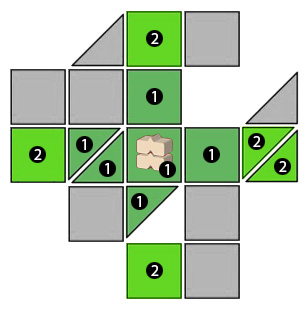 Example: The picture shows the tiles affected by the tower using different shades of green to identify tiles within range 1 and range 2. The range stretch takes into account square spaces. The tower may capture meeples in any of the tiles overlapping the square spaces in range, no matter if the space is occupied by a square tile or 1 or two triangular tiles, like in this case.
Example: The picture shows the tiles affected by the tower using different shades of green to identify tiles within range 1 and range 2. The range stretch takes into account square spaces. The tower may capture meeples in any of the tiles overlapping the square spaces in range, no matter if the space is occupied by a square tile or 1 or two triangular tiles, like in this case.
![]() Exp. 5 - Abbey & Mayor - Part 1: Abbey placement and scoring [16]
Exp. 5 - Abbey & Mayor - Part 1: Abbey placement and scoring [16]
![]() Exp. 5 - Abbey & Mayor - Part 2: Barn placement [14]
Exp. 5 - Abbey & Mayor - Part 2: Barn placement [14]
![]() The corners may be occupied by square tiles, one or two triangular tiles or double-sized tiles.
The corners may be occupied by square tiles, one or two triangular tiles or double-sized tiles.
- See the following examples involving Halfling tiles and double-size tiles (see
 Castles in Germany and
Castles in Germany and  The Markets of Leipzig.) (4/2016; updated 1/2021)
The Markets of Leipzig.) (4/2016; updated 1/2021)
- Note: The clarifications about triangular and double-sized tiles from 1/2021 override, in certain cases, the original four-tile intersection requirement for the placement of the barn defined originally for square tiles. In the end, no matter the tile geometries, a barn can only be placed at an intersection completely occupied by tiles, the same as if it there where four regular square tiles.
![]() Exp. 5 - Abbey & Mayor - Part 3: Barn scoring [17]
Exp. 5 - Abbey & Mayor - Part 3: Barn scoring [17]
![]() Exp. 6 - Count, King & Robber - Shrine scoring [18]
Exp. 6 - Count, King & Robber - Shrine scoring [18]
![]() Exp. 8 - Bridges, Castles & Bazaars - Bridge placement [19]
Exp. 8 - Bridges, Castles & Bazaars - Bridge placement [19]
![]() Mini #1 - The Flying Machines - Flier distance and placement [14]
Mini #1 - The Flying Machines - Flier distance and placement [14]
![]() Monasteries in Germany /
Monasteries in Germany / ![]() Monasteries in the Netherlands & Belgium /
Monasteries in the Netherlands & Belgium / ![]() Japanese Buildings - Abbot scoring
Japanese Buildings - Abbot scoring
 Example: RED will get 1 + 2 + 2 + 2 + 1 = 8 points from scoring his/her abbot:
Example: RED will get 1 + 2 + 2 + 2 + 1 = 8 points from scoring his/her abbot:- 1 point from the monastery tile
- 2 points from the vertical column above the monastery tile (1 point for each occupied space)
- 2 points from the vertical column below the monastery tile (1 point for each occupied space, one of them by a triangular tile)
- 2 points from the horizontal row to the left of the monastery tile (1 point for each occupied space, one of them by two triangular tiles)
- 1 point from the horizontal row to the right of the monastery tile (1 point for the space occupied by a single triangular tile)
![]() Castles in Germany - Completion of German castles [21]
Castles in Germany - Completion of German castles [21]
![]() Little Buildings - Area affected by Little Building [22]
Little Buildings - Area affected by Little Building [22]
![]() The Plague - Plague spreading [23]
The Plague - Plague spreading [23]
![]() Flea tokens move according to the square grid, independently of the tiles occupying each square space. [24]
Flea tokens move according to the square grid, independently of the tiles occupying each square space. [24]
Tile distribution
C3 version
Total Tiles: 24 halves
Halflings I
Halflings II
C2 version
Total Tiles: 24 halves
Halflings I
Halflings II
Footnotes
For Icons explanation and licensing please visit Icons page.
- ↑
 This paragraph was not included in the original rules in C2 (2nd Edition). However, it has been added for the sake of clarity, since it was clarified in 10/2024 that this ruling applicable to
This paragraph was not included in the original rules in C2 (2nd Edition). However, it has been added for the sake of clarity, since it was clarified in 10/2024 that this ruling applicable to  Castles in Germany in C3 (3rd Edition) is also valid for this expansion.
Castles in Germany in C3 (3rd Edition) is also valid for this expansion.
- ↑
 The rules in C1 (1st Edition) included a paragraph clarifying the end game conditions, but it was not included in C2 (2nd Edition). This ruling is not valid anymore:
The rules in C1 (1st Edition) included a paragraph clarifying the end game conditions, but it was not included in C2 (2nd Edition). This ruling is not valid anymore:
- Game end
- The game ends immediately at the end of the turn in which the last normal (not half-sized) land tile is placed. If any player still has any unplayed half-sized tiles in front of them, they may no longer play them.
- Game end
- ↑
 This sentence is a translation of the German rules. The English translation by HiG had a different meaning, probably by mistake: "You may also place a Meeple on an adjacent triangular tile if there already is one."
This sentence is a translation of the German rules. The English translation by HiG had a different meaning, probably by mistake: "You may also place a Meeple on an adjacent triangular tile if there already is one."
- ↑
 This comment indicates that triangular tiles are independent, even if they occupy the same square space.
This comment indicates that triangular tiles are independent, even if they occupy the same square space.
- ↑
 This sentence is based on the German wording but including the clarifications from 1/2021.
This sentence is based on the German wording but including the clarifications from 1/2021.
The English version has a different meaning, possibly by mistake: "If you complete a feature by placing a half-sized tile, it is being scored according to the rules of the base game." - ↑
 Therefore, monasteries are scored taking into account the spaces occupied by the monastery tile and by tiles (1 or 2) in the adjacent spaces. The number of tiles occupying these spaces is irrelevant. This means that a completed monastery will always score 9 points during the game.
Therefore, monasteries are scored taking into account the spaces occupied by the monastery tile and by tiles (1 or 2) in the adjacent spaces. The number of tiles occupying these spaces is irrelevant. This means that a completed monastery will always score 9 points during the game.
- ↑
 The wording has been updated to cover the cases derived from the introduction of Halflings. The original wording only mentioned the 8 adjacent tiles, assuming the rules for square tiles only: "If a monastery is being completed and scored, its owner earns 3 extra points for each vineyard depicted on the 8 tiles surrounding the monastery." With Halflings there may be up to 16 adjacent tiles. Additionally, since there is a half-sized tile with a monastery and another with a vineyard that can be placed together in the same space, this means that there may be vineyards not only on the tiles on adjacent spaces but also on the same space as the monastery. The rules should account for all these case.
The wording has been updated to cover the cases derived from the introduction of Halflings. The original wording only mentioned the 8 adjacent tiles, assuming the rules for square tiles only: "If a monastery is being completed and scored, its owner earns 3 extra points for each vineyard depicted on the 8 tiles surrounding the monastery." With Halflings there may be up to 16 adjacent tiles. Additionally, since there is a half-sized tile with a monastery and another with a vineyard that can be placed together in the same space, this means that there may be vineyards not only on the tiles on adjacent spaces but also on the same space as the monastery. The rules should account for all these case.
- ↑
 The sheep on the tile counts as a "permanent" sheep token every time that a shepherd on the associated field scores its sheep. (11/2014)
The sheep on the tile counts as a "permanent" sheep token every time that a shepherd on the associated field scores its sheep. (11/2014)
- ↑
 We are replacing this sentence with a translation of German version. The English wording is somewhat misleading : "A wolf cannot scatter your flock."
We are replacing this sentence with a translation of German version. The English wording is somewhat misleading : "A wolf cannot scatter your flock."
- ↑
 We use a translation of the German rules for clarity. The English wording is this: "Place the triangular crop circle tile according to the rules."
We use a translation of the German rules for clarity. The English wording is this: "Place the triangular crop circle tile according to the rules."
- ↑
 We used a translation of the German rules. The English rules contain a mistranslation stating that:
We used a translation of the German rules. The English rules contain a mistranslation stating that:
"Each player must either...
A) ... take a meeple from their supply and place it next to another one of their meeples of this kind on the same land tile.
OR
B) ... remove one of their meeples of the determined kind from a land tile and put it back into their supply." - ↑
 The meeple must be placed next to one of your meeple, that is, on the same feature on the same tile.
The meeple must be placed next to one of your meeple, that is, on the same feature on the same tile.
- ↑
 After several changes, the original clarification from 10/2014 is valid again. The clarifications from 10/2015 are now outdated as indicated in 1/2021.
After several changes, the original clarification from 10/2014 is valid again. The clarifications from 10/2015 are now outdated as indicated in 1/2021.
- The clarifications from 10/2015 are available on the Halflings page for the first edition.
- The clarifications from 1/2021 are available here on Carcassonne Central:
- ↑ Jump up to: 14.0 14.1 14.2 14.3
 The clarifications from 1/2021 covered this interaction and the discrepancy with the clarifications from 10/2015.
The clarifications from 1/2021 covered this interaction and the discrepancy with the clarifications from 10/2015.
- ↑
 The clarifications from 1/2021 did not covered this interaction explicitly, so the general principles provided are used in this case to be consistent with the effect of the dragon.
The clarifications from 1/2021 did not covered this interaction explicitly, so the general principles provided are used in this case to be consistent with the effect of the dragon.
- ↑
 This is an adaptation of the scoring rules for monasteries and the clarifications provided for the placement of abbeys with adjacent triangular tiles.
This is an adaptation of the scoring rules for monasteries and the clarifications provided for the placement of abbeys with adjacent triangular tiles.
- ↑
 This is a consequence of the placement of the barn ass indicated in the clarifications from 1/2021. The clarifications from 10/2015 allowed triangular gaps at an intersection with a barn. This created some issues with field continuity, that have been removed with the latest clarifications.
This is a consequence of the placement of the barn ass indicated in the clarifications from 1/2021. The clarifications from 10/2015 allowed triangular gaps at an intersection with a barn. This created some issues with field continuity, that have been removed with the latest clarifications.
- ↑
 This is an adaptation of the scoring rules for monasteries.
This is an adaptation of the scoring rules for monasteries.
- ↑
 This is an adaptation of the general principles provided. There is no explicit clarification for this interaction.
This is an adaptation of the general principles provided. There is no explicit clarification for this interaction.
- ↑
 A triangle tile takes the place of a regular landscape tile. Thus, a single triangle hole (half-tile hole) in the map does not stop the row or column for scoring for German and Dutch/Belgian Monasteries. Only a hole of a complete regular landscape tile interrupts the row or column. (3/2015)
A triangle tile takes the place of a regular landscape tile. Thus, a single triangle hole (half-tile hole) in the map does not stop the row or column for scoring for German and Dutch/Belgian Monasteries. Only a hole of a complete regular landscape tile interrupts the row or column. (3/2015)
 This clarifications would also apply to Japanese Buildings.
This clarifications would also apply to Japanese Buildings.
- ↑
 There are no explicit clarifications about scoring German castles. This is an adaptation of the scoring taking into consideation the scoring for monasteries.
There are no explicit clarifications about scoring German castles. This is an adaptation of the scoring taking into consideation the scoring for monasteries.
- ↑
 There is no official clarification regarding how Little Buildings interact with Halflings beyond the general considerations provided.
There is no official clarification regarding how Little Buildings interact with Halflings beyond the general considerations provided.
- ↑
 There are no explicit clarifications about spreading the plague after the clarifications from 10/2015. The approach applied combines those for the dragon and German monasteries.
There are no explicit clarifications about spreading the plague after the clarifications from 10/2015. The approach applied combines those for the dragon and German monasteries.
- ↑
 Given the clarification provided for German monasteries, it seems apparent that a single triangle hole would not prevent spread of the Plague in that direction, as the presence of a Halfling still counts as a full tile with no official gap. (3/2015)
Given the clarification provided for German monasteries, it seems apparent that a single triangle hole would not prevent spread of the Plague in that direction, as the presence of a Halfling still counts as a full tile with no official gap. (3/2015)


